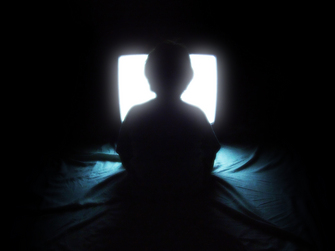« Prev Next »

A new type of consumer has evolved in recent years—the love child of the Couch Potato and the Channel Surfer, raised by streaming devices and nurtured by entire seasons of shows available at the click of a remote.
For just a few dollars a months, subscribers to Netflix, Hulu Plus, and Amazon Instant Video have access to thousands of streaming movies and TV shows updated regularly. And with Netflix's new post-play feature, which prompts viewers to play the next episode just as the credits of the last one begin rolling, it's easier than ever to succumb to the captivating lure of Walter White and Frank Underwood.
Indeed, the birth of the "binge-watcher" has been an intriguing, unexpected development in the past five years. Neuroscience, it turns out, can partially explain the phenomenon.
British psychologist Edward B. Titchener (1867-1927) might argue that we become glued to complex, emotionally-charged stories because of our ability to recognize the feelings of others. A newly-identified phenomenon at the time, Titchener coined the term "empathy" in 1909. In addition to identifying others' discomfort or elation, the branch of "cognitive empathy" examines how humans can also adopt others' psychological perspectives, including those of fictional characters. It's such a universal emotional state that psychological tests (through the use of puppets, pictures, and videos) have even been developed to study empathy in preschool-aged children.
Neuroeconomist Paul Zak of Claremont Graduate University set out to examine the science of empathy in storytelling. He showed participants a video about a young boy with terminal cancer, seemingly joyful and completely unaware of his fate. We get the father's perspective, too-although he tries to enjoy his last months with his son, he finds it impossible to be happy.

After watching the video, participants were also given the opportunity to donate money to a stranger in the laboratory, as well as a charity that helps sick children. In both cases, the amount of cortisol and oxytocin released predicted how much people were willing to share. Zak concludes that these empathetic feelings (that we also, apparently, act on) are evidence of our compulsions as social beings-even when faced with a fictional story.
So it's clear that humans connect emotionally with stories of their kin. But what explains the binge? Or why, according to Netflix, did three of four members who streamed the first season of Breaking Bad finish all seven episodes in one session?
Psychologist Uri Hasson of Princeton University pioneered the new field of "neurocinematics," or the study of how TV and film interact with the brain. In a 2008 study, Hasson and colleagues showed participants four clips while they had their brain imaged via fMRI: Larry David's Curb Your Enthusiasm, Sergio Leone's The Good, the Bad and the Ugly, Alfred Hitchchock's Bang! You're Dead, and 10-minute unedited, one-shot video of a Sunday morning concert in NYC's Washington Square Park.
Hasson wanted to determine the inter-subject correlation (ISC) across all viewers' brains to examine how similarly they'd respond while watching these four very different clips. The Washington Square Park video only evoked a similar response in all viewers in only 5% of the cortex, while Curb Your Enthusiasm and The Good, The Bad and the Ugly came in at 18% and 45%, respectively. The Alfred Hitchcock film, however, elicited an ISC of 65%.
In other words, compared to the other films, Bang! You're Dead was able to coordinate the responses of many different brain regions, resulting in simultaneous "on" and "off" responses across all participants 65% of the time. Hasson concluded that the more "controlling" the clip-in other words, showing the viewer exactly what they're supposed to pay attention to-the more focused the audience.
While the one-shot park clip allows viewers to attend to anything they find interesting, Hitchcock was a master of orchestrating everything: what you're watching, what you're thinking, how you're feeling, and what you predict will come next. In the same way, modern-day TV writers and directors can engage viewers worldwide with the flash-forwards of LOST, gruesome Game of Thrones action, or the eerie exchanges between Breaking Bad's Gus Fring and Walter White.
In a study by Harris Interactive on behalf of Netflix released in December, 61% of 1,500 online respondents claimed to binge-watch Netflix regularly (defined, modestly, as watching at least two or three episodes successively every few weeks). Three quarters of them reported having positive feelings toward the behavior.

A new report shows that the average American watches over five hours of television daily. This statistic comes at the same time that we learn how sitting is slowly killing us, and that sedentary time in older age puts one at a significant risk for disability.
To ensure that you're not binge-eating and binge-sitting while binge-watching, perhaps you could do like Claire Underwood did for Frank and set up a nifty little rowing machine in front of your screen. Because for the same reasons we're wired to binge-watch TV, our brains also crave a good workout session.
--
A version of this was originally published at The Conversation UK.
Image credit: Aaron Escobar, Pete Souza, Bryan Gosline (Wikimedia Commons)
Hasson, U., O. Landesman, B. Knappmeyer, I. Vallines, N. Rubin, and D.J. Heeger. Neurocinematics: the Neuroscience of Film. Projections 2(1): 1-26 (2008).
Zak, P.J., A.A. Stanton, and S. Ahmadi. Oxytocin increases generosity in humans. PLOS ONE 2(1): e1128 (2007).






















